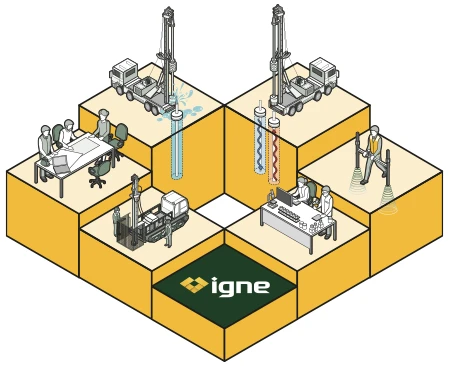

Void Detection with GPR Surveys
Ground-related construction issues are a significant cause of delays and cost overruns; sometimes they stem from undetected underground voids.
About
What Is Void Detection?
From storm tanks and fuel tanks to septic tanks and historical mine workings, unearthing these hidden voids can save projects from considerable risk.
Igne’s comprehensive ground penetrating radar (GPR) survey services offer a proven solution to this problem, ensuring that voids are identified early, safely, and in a cost-effective way.
Void detection refers to the process of locating and mapping empty spaces or cavities beneath the surface, which may have formed naturally or as a result of human activities.
These voids could be anything from disused mine workings to buried storm, fuel, or septic tanks. If left undetected, they can pose serious risks to construction projects, leading to ground instability, structural failures, and environmental hazards.
Igne’s void detection surveys utilise GPR technology to scan beneath the surface and identify these voids. With our experience in geotechnical and environmental investigations, we deliver accurate, timely data that de-risks your project and informs your decision-making.
Expertise
Why Commission Igne’s GPR Survey Services for Void Detection?
Commissioning Igne’s GPR surveys for void detection offers more than just peace of mind—it provides a clear path to success for any project involving intrusive groundworks. Our team of surveyors employs the latest GPR technology to detect and map voids with precision, allowing you to manage risks proactively.
When you work with Igne, you gain access to our in-house specialists, whose extensive knowledge in site investigation ensures that even the most challenging voids are detected. This expertise, combined with our commitment to delivering high-quality data, sets us apart.
We focus on providing actionable insights that help you plan for construction, demolition, or development with complete confidence.
Whether you’re working on residential, commercial, or infrastructure projects, Igne’s void detection services are essential for any development that requires groundworks. Our surveys cover a broad range of sectors, and our reputation for thoroughness and accuracy has made us a trusted partner across the construction industry.
The Risk
Risks of Not Identifying Voids Before Intrusive Ground Works
Failing to identify voids before groundworks begin can lead to significant problems. Void detection is critical for maintaining the safety, stability, and financial viability of your project. Without proper investigation, hidden voids can cause:
Ground Collapse
unidentified voids, such as old mine workings or large buried tanks, can lead to ground subsidence or collapse, posing a major risk to both site workers and structures.
Structural Failure
voids that are located directly beneath or adjacent to buildings or infrastructure can compromise foundations, leading to catastrophic structural failures
Environmental Hazards
buried fuel tanks or septic tanks, if damaged during excavation, can cause serious contamination issues, leading to environmental damage and costly clean-ups.
Increased Costs
discovering voids during construction often leads to unplanned delays and expensive remedial works. Identifying these voids beforehand allows for more efficient project planning and cost control.
Identify
How Voids are Identified Using GPR Surveys
GPR technology is highly effective for identifying voids beneath the ground’s surface. It works by emitting high-frequency radio waves that penetrate the subsurface and reflect back signals when they encounter changes in material composition.
These reflections are captured and analysed to create a detailed map of what lies beneath the surface.
For void detection, GPR is particularly useful because it can differentiate between solid ground and empty spaces. Whether the void is a man-made structure like a tank or a naturally occurring cavity, the technology is sensitive enough to detect even small variations in subsurface density.
At Igne, our GPR surveys are conducted by trained professionals who know how to interpret complex data sets to provide an accurate picture of underground conditions. Once the survey is completed, we generate a comprehensive report that details the location, size, and depth of any voids detected.
Design & Plan
Designing & Planning a Void Detection Survey
The design and planning of a void detection survey is customised to the specific needs of each site. At the start, we work closely with our clients to gather as much information as possible about the site’s history and intended use. This helps us identify the most likely areas where voids may be present, such as locations known for historical mining activity or where fuel or septic tanks might have been installed.
Once the target areas are identified, our team uses state-of-the-art GPR technology to scan the site. This involves passing GPR equipment over the ground surface in a systematic way to ensure full coverage of the area. The resulting data is then analysed to produce a clear map of any voids present.
For example, locating voids such as storm, fuel, or septic tanks requires precise scanning over suspected storage areas. In the case of old mine workings, GPR can detect the presence of collapsed shafts or empty tunnels that may not be evident from the surface.
Benefits
Benefits of GPR Surveys in Locating Voids
The benefits to using GPR surveys for void detection include:
Early Identification of Risks
GPR surveys can detect voids early in the planning stages, helping you address potential issues before groundworks begin. This reduces the risk of delays and unexpected costs
Non-Invasive & Safe
GPR is a non-invasive technology that allows for subsurface mapping without the need for intrusive drilling or excavation. This minimises environmental disruption and preserves the site’s integrity.
Versatile & Accurate
GPR can detect a wide variety of voids, including both man-made and natural cavities. It is highly effective across different types of ground conditions and can deliver precise results even in challenging environments.
Cost-Effective
By identifying voids early, GPR surveys help avoid costly surprises during construction. This allows for better budget management and ensures projects stay on track.
Regulatory Compliance
Many construction projects require void detection as part of regulatory compliance. Igne’s GPR surveys provide the thorough documentation needed to satisfy planning authorities and ensure that your project meets all relevant standards.
Learn More
Frequently Asked Questions about Void Detection GPR Surveys
- What types of voids can GPR detect?
GPR can detect various types of voids, including storm tanks, fuel tanks, septic tanks, mine workings, and naturally occurring cavities.
- How accurate are GPR surveys in detecting voids?
GPR surveys are highly accurate in identifying the location, size, and depth of voids. However, factors such as soil composition and moisture content can affect the results.
- Is GPR the best method for detecting voids?
GPR is one of the most effective methods for void detection, particularly for non-invasive subsurface investigations. It is widely used in construction and infrastructure projects for its accuracy and safety.
- Can GPR detect small voids?
Yes, GPR can detect both large and small voids, though its accuracy depends on factors like the depth of the void and the type of material surrounding it.
- What are the benefits of detecting voids early?
Detecting voids early in the planning process helps prevent ground collapse, structural failure, and unexpected costs, ensuring that projects proceed smoothly.
- How long does a void detection survey take?
The time needed for a void detection survey depends on the size and complexity of the site. Most surveys can be completed within a day, with data analysis taking a few additional days.
The Next Step
At Igne, we offer specialist void detection services to help you avoid the risks that hidden voids pose to your project.
Our GPR surveys deliver accurate, reliable data that allows you to make informed decisions.
Contact us today to learn more about our void detection services, and trust us to de-risk your project by detecting voids before they become an issue.

